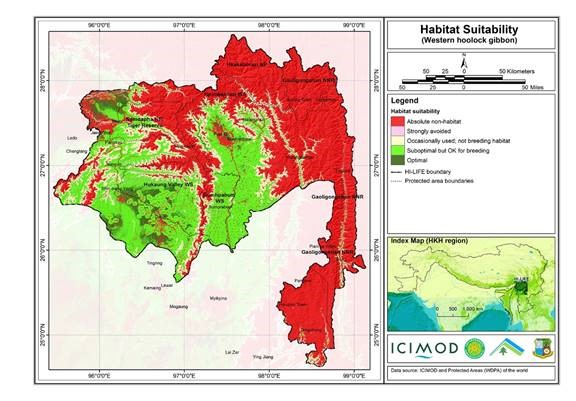Habitat suitability data for the Western hoolock gibbon
The Hindu Kush Himalayan region (HKH) is an important biodiversity hotspot with more than 488 protected areas covering 39% of the region's geographical coverage. A majority of the protected areas are small and isolated and are not large enough to address conservation challenges. Only about 20% of the protected areas are transboundary in nature. There is limited data available on habitat suitability for conservation planning and landscape management in the Far Eastern Himalayan Landscape. A study carried out under the Landscape Initiative for Far Eastern Himalayas (HI-LIFE) Initiative at ICIMOD, estimates habitat suitability for the Western hoolock gibbon in the Far Eastern Himalayas using remote sensing and geographic information system tools, and available secondary information.
Simple
- Date ( Publication )
- 2021-03-30
- Other citation details
- Creative Commons Attribution 4.0 International (CC BY 4.0) (https://creativecommons.org/licenses/by/4.0/)
- Purpose
- Using geospatial tools to understand species habitat suitability for conservation planning in the Far Eastern Himalayas.
- Status
- Completed
- Maintenance and update frequency
- As needed
- ( Theme )
-
- Habitat Suitability
- HILIFE
- Transboundary Landscape
- Western hoolock gibbon
- Protected Areas
- Keywords ( Place )
-
- Far Eastern Himalayan Landscape
- Myanmar
- China
- India
- Use limitation
- Free to use with attribution to the source. Suggested citation: ICIMOD. (2021). Habitat suitability data for the Western hoolock gibbon [Data set]. ICIMOD. https://doi.org/10.26066/RDS.1972573
- Access constraints
- License
- Use constraints
- License
- Other constraints
- Creative Commons Attribution 4.0 International (CC BY 4.0) (https://creativecommons.org/licenses/by/4.0/)
- Denominator
- 100000
- Metadata language
- eng
- Character set
- UTF8
- Topic category
-
- Biota
N
S
E
W
))
- Reference system identifier
- WGS 1984
- Hierarchy level
- Dataset
- File identifier
- 13d41f25-efa0-419f-bc04-c155f0fb15ee XML
- Metadata language
- eng
- Character set
- UTF8
- Hierarchy level
- Dataset
- Date stamp
- 2025-07-16T15:02:36
- Metadata standard name
- North American Profile of ISO 19115:2003
 Metadata Catalogue
Metadata Catalogue


